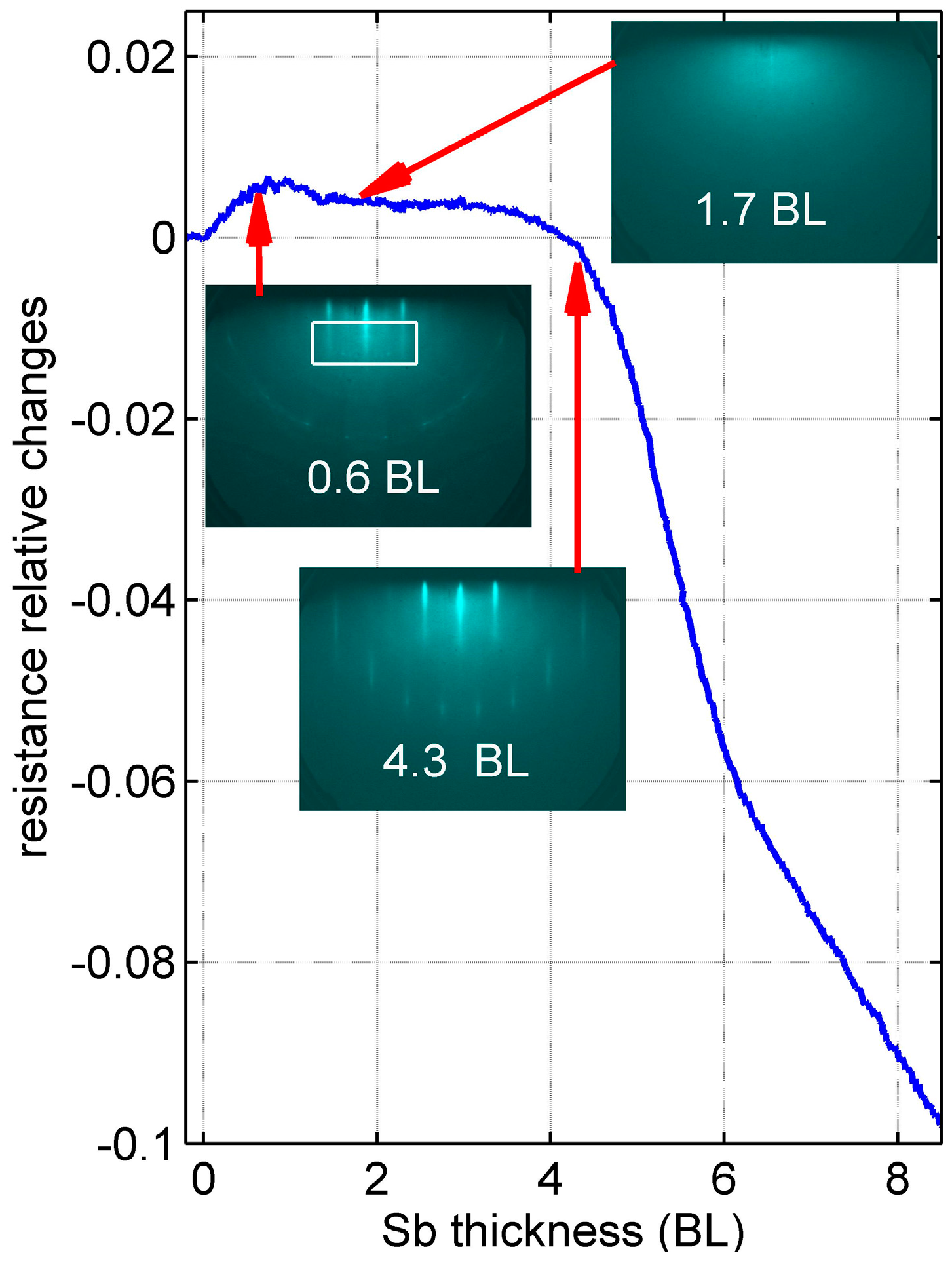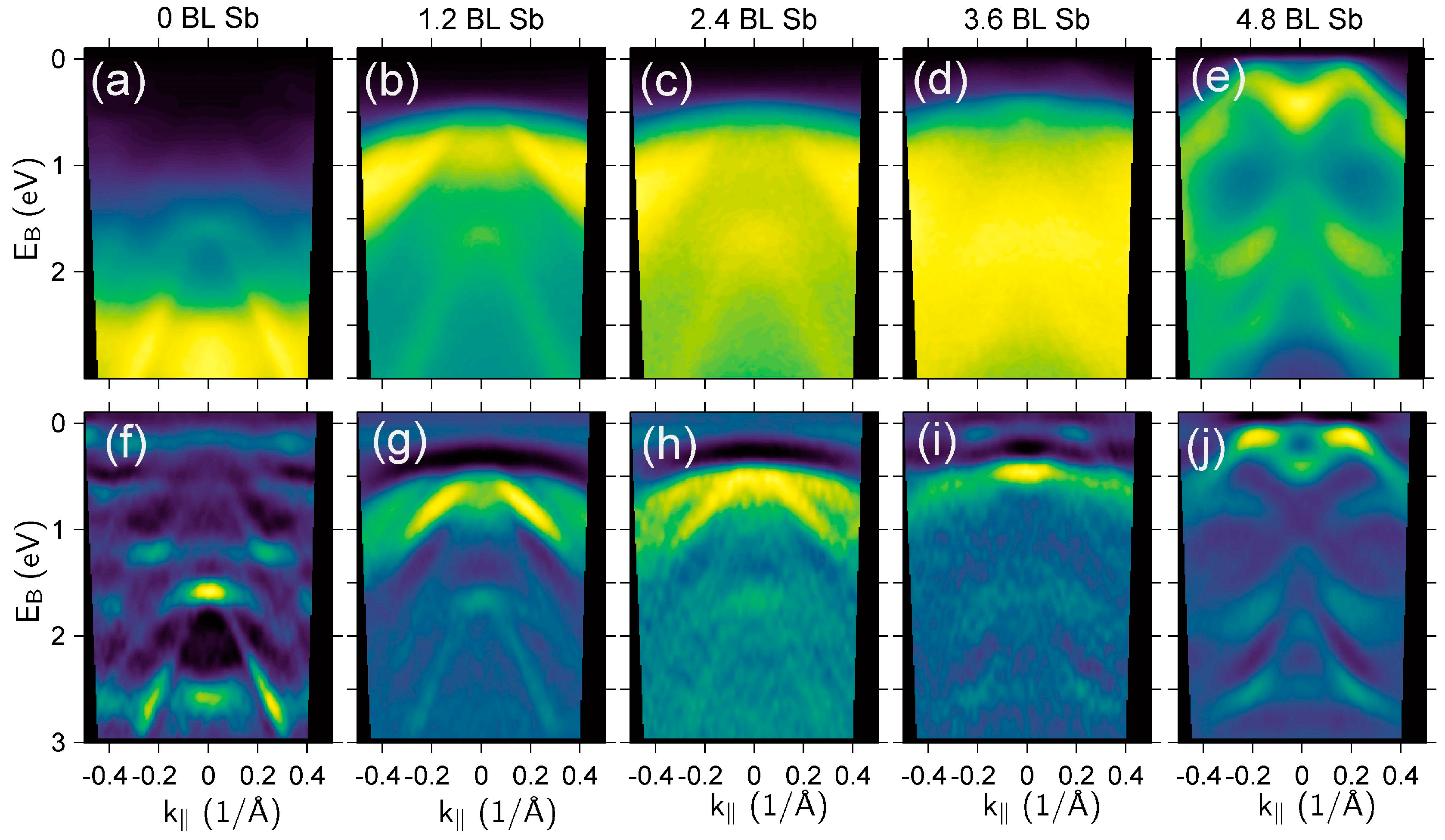Early Stage of Sb Ultra-Thin Film Growth: Crystal Structure and Electron Band Structure
Abstract
:1. Introduction
2. Methods and Parameters
3. Results and Discussion
3.1. Crystal Structure and Electric Transport of Sb Layers Grown on Si(111)-(6 × 6)Au
3.2. Electron Band Structure of Ultra-Thin Sb Films
4. Conclusions
Acknowledgments
Author Contributions
Conflicts of Interest
References
- Zhang, P.F.; Zheng, L.; Duan, W.; Liu, F.; Wu, J. Topological and electronic transitions in Sb(111) nanofilm: The interplay between quantum confinement and surface effect. Phys. Rev. B 2012, 85, 201410(R). [Google Scholar] [CrossRef]
- Fu, L.; Kane, C.L. Topological insulators with inversion symmetry. Phys. Rev. B 2007, 76, 045302. [Google Scholar] [CrossRef]
- Wang, S.-X.; Zhang, P.; Li, S.-S. Topological properties of Sb(111)surface: A density functional theory study. 2012; arXiv:1201.1976. [Google Scholar]
- Chuang, F.C.; Hsu, C.H.; Chen, C.-Y.; Huang, Z.-Q.; Ozolins, V.; Lin, H.; Bansil, A. Tunable topological electronic structures in Sb(111) bilayers: A first-principles study. Appl. Phys. Lett. 2013, 102, 022424. [Google Scholar] [CrossRef]
- Wang, D.; Chen, L.; Liu, H.; Wang, X. Topological phase transition in Sb(111)films driven by external strain and electric field. EPL 2013, 104, 57011. [Google Scholar] [CrossRef]
- Wang, D.; Chen, L.; Liu, H.; Wang, X.; Cui, G.; Zhang, P.; Zhao, D.; Ji, S. Topological states modulation of Bi and Sb thin films by atomic adsorption. Phys. Chem. Chem. Phys. 2015, 17, 3577–3583. [Google Scholar] [CrossRef] [PubMed]
- Jałochowski, M.; Bauer, E. Quantum size and Surface effects in the electrical resistivity and high-energy electron reflectivity of ultrathin lead films. Phys. Rev. B 1988, 38, 5272–5280. [Google Scholar] [CrossRef]
- Stępniak, A.; Nita, P.; Krawiec, M.; Jałochowski, M. In and Si adatoms on Si(111)5 × 2-Au: Scanning tunneling microscopy and first-principles density functional calculations. Phys. Rev. B 2009, 80, 125430. [Google Scholar] [CrossRef]
- Jałochowski, M.; Kwapiński, T.; Łukasik, P.; Nita, P.; Kopciuszyński, M. Correlation between morphology, electron band structure, and resistivity of Pb atomic chains on the Si(553)-Au surface. J. Phys. Condens. Matter 2016, 28, 284003. [Google Scholar] [CrossRef] [PubMed]
- Hasegawa, S.; Tong, X.; Takeda, S.; Sato, N.; Nagao, T. Structures and electronic transport on silicon Surfaces. Prog. Surf. Sci. 1999, 60, 89–257. [Google Scholar] [CrossRef]
- Barrett, C.S.; Cucka, P.; Haefner, K. The crystal Structure of Antimony at 4.2, 78 and 298 K. Acta Cryst. 1963, 16, 451–453. [Google Scholar] [CrossRef]
- Üzengi Akturk, O.; Ongun Özçelik, V.; Ciraci, S. Single-layer-crystalline phase of antimony: Antimonenes. Phys. Rev. B 2015, 91, 235446. [Google Scholar] [CrossRef]
- Bianconi, A.; Marcelli, A. (Eds.) Atomically Controlled Surfaces, Interfaces and Nanostructures; Superstripes Press: Rome, Italy, 2016; ISBN 9788866830597.



© 2016 by the authors; licensee MDPI, Basel, Switzerland. This article is an open access article distributed under the terms and conditions of the Creative Commons Attribution (CC-BY) license ( http://creativecommons.org/licenses/by/4.0/).
Share and Cite
Stróżak, M.; Kopciuszyński, M.; Stępniak-Dybala, A.; Krawiec, M.; Jałochowski, M. Early Stage of Sb Ultra-Thin Film Growth: Crystal Structure and Electron Band Structure. Condens. Matter 2016, 1, 11. https://doi.org/10.3390/condmat1010011
Stróżak M, Kopciuszyński M, Stępniak-Dybala A, Krawiec M, Jałochowski M. Early Stage of Sb Ultra-Thin Film Growth: Crystal Structure and Electron Band Structure. Condensed Matter. 2016; 1(1):11. https://doi.org/10.3390/condmat1010011
Chicago/Turabian StyleStróżak, Mirosław, Marek Kopciuszyński, Agnieszka Stępniak-Dybala, Mariusz Krawiec, and Mieczysław Jałochowski. 2016. "Early Stage of Sb Ultra-Thin Film Growth: Crystal Structure and Electron Band Structure" Condensed Matter 1, no. 1: 11. https://doi.org/10.3390/condmat1010011
APA StyleStróżak, M., Kopciuszyński, M., Stępniak-Dybala, A., Krawiec, M., & Jałochowski, M. (2016). Early Stage of Sb Ultra-Thin Film Growth: Crystal Structure and Electron Band Structure. Condensed Matter, 1(1), 11. https://doi.org/10.3390/condmat1010011




